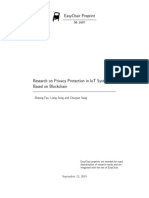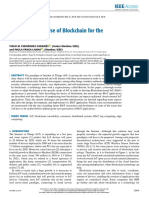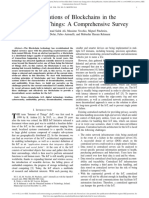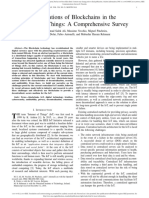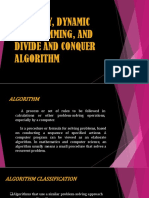iot_blockchain_pp
Uploaded by
Najmus Sakib Sizan181-115iot_blockchain_pp
Uploaded by
Najmus Sakib Sizan181-115Enhancing IoT Security and Privacy with Distributed Ledgers -
a Position Paper
Paul Fremantle1 , Benjamin Aziz1 and Tom Kirkham2
1 Schoolof Computing, University of Portsmouth, Portsmouth, UK
2 Scienceand Technology Funding Council, Harwell, UK
{paul.fremantle, benjamin.aziz}@port.ac.uk, tom.kirkham@stfc.ac.uk
Keywords: Internet of Things, Blockchain, Distributed Ledgers, Security, Privacy, Blockchains
Abstract: The Internet of Things has a number of well-publicised security flaws, resulting in numerous recent attacks.
In this paper we lay out a framework for looking at how distributed ledgers and Blockchain technology can be
used to enhance the security, privacy and manageability of IoT devices and networks. A significant concern is
the inability to process blockchains on small devices. We propose an architecture for IoT security and privacy
based on blockchains that addresses this and other issues. We look at related work and propose areas of further
research.
1 INTRODUCTION tively, each transaction recorded in the blockchain
can support arbitrary logic which is coded in a script-
The Internet of Things (IoT) consists of the set of ing language, which is Turing complete. This ability
Internet-connected devices that collect sensor data to create new transactions through the use of script-
and allow control of actuators to measure and affect ing languages is commonly known as Smart Con-
the physical world. tracts. Together these three constructs — Distributed
Concerns over the security and privacy of the In- Ledger, Cryptocurrency and Smart Contracts — cre-
ternet of Things reached a new high when the Mi- ate an environment where a set of parties can share in
rai botnet caused massive disruption to the Internet the governance of the system, even when the identi-
in September 2016. In Fremantle and Scott (2015), ties and reputation of the parties is not known. Each
a number of issues are identified for security of IoT. party participates in guaranteeing the good behaviour
The direct cause of the Mirai attack was the use of of the others and of the set of transactions. The bene-
a dictionary password attack on devices connected to fit of this is that it provides a fair and unbiased system
the Internet that offered direct access. Other security whereby users can trust in the integrity of the system
concerns about IoT devices include significant chal- independent of any single parties’ overall behaviour.
lenges in updating devices; lack of clear and effective We propose that this shared governance model has
registration processes; lack of well defined identity significant benefits for the security and privacy of the
models; use of IoT devices as attack vectors into more Internet of Things. In this work, we argue that the spe-
secure systems; and attacks on physical systems such cific characteristics of the blockchain provide unique
as Stuxnet (Langner, 2011). approaches to solving problems in the IoT.
Distributed Ledger technology, which is based on The contributions of this paper are: a model for
the Blockchain (Nakamoto, 2008) construct, provides reasoning about how blockchains can improve pri-
a new class of distributed technologies. These sys- vacy and security in IoT; a set of approaches for im-
tems are famous for being the basis of cryptocur- proving security and privacy of IoT with blockchains,
rencies, where there is a fully decentralised system derived from the model; and a proposed architecture
with no central bank. Such systems are charac- for creating distributed trust in a blockchain on low-
terised by a distributed, secure, ledger that provides power devices.
an immutable, assured record of a set of transactions. The rest of the paper is laid out as follows. In
While some blockchains such as Bitcoin have re- Section 2 we propose reasons why distributed ledger
stricted transaction models, others, such as Ethereum, technologies can help with IoT privacy and security.
support more complex transaction models. Effec- In Section 3 we outline a model for reasoning about
security and privacy for IoT, and use that model to untrustworthy. Bitcoin, the most famous blockchain-
identify areas where distributed ledgers can assist. In based system, relies on a concept called Proof of Work
Section 4, we propose an implementation plan that to ensure that parties are behaving properly. Other
addresses these issues. In particular we aim to solve blockchain systems rely on differing proofs, includ-
the problem of how to provide trust in a blockchain ing proof of stake, proof of storage, or combinations
from a device that lacks the power to participate in the of different proof types. The proof is used to guar-
blockchain. In Section 5 we compare this approach to antee the immutability of an block and each block
related work, and outline a plan of further work in this guarantees the previous blocks (typically using a con-
area. struct known as a Merkle Tree) — creating a chain
of blocks known as a blockchain. Because the proof
requires some form of value (whether it is ownership
2 MOTIVATION of a cryptocurrency, expended work, storage of data,
etc), the system can provide rewards for those who
Because of the widespread deployment of IoT to- participate. This is the basis of cryptocurrencies. For
gether with the use in many areas where personal in- example, Bitcoin issues new coins to the participat-
formation can be collected or deduced — including ing system that first correctly produces the work that
smart homes, health monitoring, smart cars, and fit- verifies the latest block.
ness tracking — there are ongoing major concerns Therefore, the distributed ledger offers the
about privacy. These include: lack of informed con- promise of creating an environment for IoT networks
sent for publishing data; fingerprinting of hardware; where there can be trust, anonymity, and effective
and de-anonymisation, amongst others. contracts between parties without any single vendor
The Web and Internet have been driven by hetero- being in charge, and without requiring any party to
geneity of clients and services: any browser will work trusted above any other.
with any website; any FTP client with any FTP server.
This choice enables several security and privacy bene- However, there remains a major concern. The
fits. Users can migrate away from insecure or privacy- processing, memory and code requirements of
leaking systems and services. It also encourages both blockchains makes them inappropriate to run on IoT
client and service providers to produce security up- devices and gateways. For example, the current Bit-
dates and improvements to the core protocols and coin database is around 80Gb and it takes at least
to the websites and services provided. While there 512MB of RAM and a 1Ghz processor to partici-
are problems, this has led to incremental improve- pate 3 . The Simple Payment Verification (SPV) model
ments and choices. For example, users concerned in Bitcoin supports lighterweight clients that can con-
about email integrity and spamming can adopt anti- nect to a random sample of servers, but this is sus-
spam measures such as the Domain Key Identified ceptible to Sybil attacks. Recent work in Frey et al.
Mail standard (Crocker et al., 2011). Users concerned (2016) has made it feasible to participate in the Bit-
with confidentiality can encrypt email. Users con- coin network with a smartphone, but to have an effec-
cerned about insecure messaging systems can choose tive approach for IoT the system must support com-
more secure instant messaging systems such as Sig- mon cheap IoT devices. For example, the ESP8266
nal1 and Threema2 . In contrast, the Internet of Things device is a common device target that offers 1Mb
is fundamentally controlled by the manufacturers of of program memory and 80Kb of variable memory.
devices, and does not offer choice for users to migrate Even with the improvements from Frey et al, this
to more secure services. IoT devices are hard-coded is still insufficient even to validate the Bitcoin sys-
with firmware that typically connects to a single ser- tem. As a result, we consider this a significant is-
vice. In many cases the only true privacy control a sue that needs addressing before the vision of using
user has is to completely disable a device. Even when blockchains as the basis of IoT security and privacy
systems use standard protocols, they may not docu- can be achieved. To solve this problem, we propose
ment the usage. an avenue of research that can provide trust between
As discussed above, blockchains create a dis- IoT devices and blockchains without requiring the de-
tributed ledger that creates a shared governance. vice to actively participate in the blockchain.
Blockchains rely on proof that the parties are behav-
ing in a consistent and correct manner, since the par-
ties are not known and are assumed to be inherently
1 https://whispersystems.org/ 3 https://bitcoin.org/en/bitcoin-core/
2 https://threema.ch/en features/requirements
3 MODEL Devices need to have secure identities (Fremantle
et al., 2014), and currently these are either not pro-
Spiekermann and Cranor (2009) offer a model for vided, or provided by the device manufacturer. Sys-
looking at user privacy. In their model, they identify tems such as NameID 4 provide a model whereby
three spheres: the User Sphere, the Joint Sphere and secure Web identities can be provided with no cen-
the Recipient Sphere. The User Sphere is completely tral trusted system. Instead a distributed ledger (in
in the control of the user (e.g. a laptop). The Joint this case Namecoin) provides a neutral shared system.
Sphere refers to areas that may seem to be in the user’s This approach can be extended to IoT to issue each
control, but may have some significant control by a device with a secure identity based on a distributed
third-party. For example, a cloud email account may ledger.
seem like the user can delete emails, but the cloud A second, related issue, is the ownership of de-
provider may in fact back these up and keep a copy. vices. The Mirai botnet spread because dictionary
Finally, once data has been transferred to a third-party, attacks allowed attackers to take ownership of de-
it is assumed to be in the Recipient Sphere, where the vices. Some systems offer models of taking owner-
only controls are legal and contractual. ship securely (e.g. Bluetooth, NFC). In (Fremantle
In the model, a device that offers the user full con- and Aziz, 2016), a QR code is used in conjunction
trol is firmly in the User Sphere. However, we would with a Web-based system. We propose that the cryp-
argue that many current devices are actually in the tocurrency model of blockchains provides a safer and
Joint Sphere. This is where the device appears to be in clearer model of ownership. Distributed ledgers im-
the control of the user but in fact is in the control of a plicitly support ownership: a Bitcoin transaction is
third-party. To give an example, the Google Nest de- the transfer of some bitcoins from own owner to an-
vice offers users the opportunity to apply smart heat- other. Similarly, a blockchain for IoT could support
ing controls to their house. While a number of user- the transfer of ownership of a device from the manu-
centred controls give the user the impression that it facturer to the user, and from one user to another. The
is in the User Sphere, there are two key reasons to security of this is therefore based on the security of
counter this: firstly, the data logged by the device is the blockchain.
extensive and cannot be controlled by the user; sec- A third issue within the User Sphere is updating
ondly, the device auto-updates itself based on com- the device firmware. A number of attacks have orig-
mands from Google rather than based on user input. inated in lack of updates. One issue is that device
Using this model, we can propose clear ap- manufacturers are incentivised to create new products
proaches that strengthen each of the privacy and se- but not to update old products. In (Tindall, 2015), a
curity controls available in each sphere. Figure 1 pro- model is proposed whereby devices can pay for up-
vides an overview of this model. dates in a cryptocurrency. In addition, blockchains
could be used as the basis for building trust in updates
and also in validating updates.
3.2 Joint Sphere
Recall that the Joint Sphere is the parts of the system
where the user has some form of control over their
data and systems, but the provider also shares con-
trol. For example, a health-monitoring device may
upload data to an Internet-based system and then may
Figure 1: IoT Blockchain applied to Privacy Model offer users controls on how they share data. A ma-
jor change in legislation around this is the European
Union’s General Data Protection Regulation (GDPR)
3.1 User Sphere which requires much stronger consent controls. Many
systems offer forms of user consent for sharing data
Moving privacy and security controls back to the with third parties, but these lack significant require-
users inherently strengthens the User Sphere and pro- ments. For example, many users are not aware of how
vides greater choice, thereby allowing more secure to revoke consent. Similarly, there is no clear place a
approaches to flourish. We have identified a number user can identify all the consents they have approved
of controls which can be managed by a distributed
ledger. 4 http://nameid.org
across different devices. Consent is not just about pri- Spotting these illicit data shares can possibly be
vacy. IoT devices often include actuators that can act done using a concept of a Trap Street. This is the habit
based on Commands, and the security of a device in- that map-makers have of including incorrect data to
cludes ensuring that only authorised systems can issue see if others copy it. Similarly, IoT devices could de-
commands to devices. liberately share incorrect data to specific parties to see
We propose that consent be treated as a contract if it leaks out without a ledger entry to record it.
in a distributed ledger system. This has several ben- A similar capability that could be implemented us-
efits. Firstly, this creates a clear ledger of all issued ing distributed ledgers and smart contracts is that of
consents. Secondly, this creates a clear contractual Data revocation. This would be a situation where a
obligation on the recipient of the consent to behave smart contract is used to trigger the secure deletion of
according to the contract, which could (for example) specific data.
specify penalties for breaking the contract. Finally, In summary, we have seen a number of ways
this model creates a clear opportunity for revocation where distributed ledgers can enhance privacy and se-
of consent, giving a single place to do so. curity of IoT. We now look at a proposed implemen-
A related area is that of policies. In this meaning tation.
a policy is a computer-readable expression of rights
and obligations. For example, a consent approval
may refer to a policy: the user might approve sharing
of data to a website based on the fact that the web-
4 PROPOSED
site promises not to share the data to any other body. IMPLEMENTATION
Languages such as XACML (Godik et al., 2002) al-
low complex access control policies to be encoded in The biggest concern we have regarding the imple-
XML or JSON. We propose that a distributed ledger mentability is the inability of small devices to par-
could be used to store and validate policies in an im- ticipate in blockchains. Many blockchains provide
mutable model that could be then used by IoT net- lighter-weight models of validation such as the Bit-
works and consent models. In addition, the policies coin SPV5 and the Ethereum Light Client Protocol6 .
could themselves refer to transactions in a distributed However, even these may require more processing
ledger. We will describe this in the Recipient Sphere. than an IoT device can provide, and this requirement
may also increase in the future with the growth in the
3.3 Recipient Sphere blockchain ledger.
There already exists a concept in the blockchain
system of an Oracle. An oracle is a system that re-
The Recipient Sphere is the area where the user’s data ports on the world to the blockchain in a reliable fash-
is now out of their control. Ultimately, the user must ion. For example, a smart contract may require pay-
rely on legislation or legal contracts in order to main- ment when a certain condition is met, and the oracle
tain control of this data. However, we propose that is used to report to the blockchain when that condi-
distributed ledgers can offer a significant benefit in tion exists. We propose that the IoT and Blockchain
this space. For example, suppose that a user shares require the exact opposite - a trusted intermediary that
data with a third-party using a smart contract to en- reports on the state of the blockchain on behalf of the
able consent. The contract refers to a policy that says IoT device. Such an entity, which we call a Pythia,
the third-party can only share that data with others could interact with the blockchain on behalf of IoT
(on-bound sharing) if they inform the user of that devices and do so in a trusted fashion. Therefore, it
on-bound sharing. This policy could point to a new would act both as an oracle to the device, as well as
smart contract that must be executed at the point of an oracle to the blockchain.
on-bound sharing. By executing this second contract, In order to allow the Pythia to be trusted, we
the on-bound sharing is logged immutably into a dis- propose creating an Open Source codebase that
tributed ledger. Of course, it is hard to police this re- would be run using Intel Secure Guard eXtensions
cipient sphere: it is possible that the third-party web- (SGX) (Costan and Devadas, 2016). SGX provides
site will share data without executing the contract. a secure enclave within modern Intel processors that
There are two defences against this. The first is that provides two key benefits that are required by the
they are explicitly breaking a contract and penalties
can occur. In fact, we can envision that these penal- 5 https://en.bitcoin.it/wiki/Thin_Client_
ties could be implemented directly in the ledger by Security
smart contracts. If the user can prove data was shared 6 https://github.com/ethereum/wiki/wiki/
illicitly, the payment would be automatic. Light-client-protocol
Pythia model. Firstly, the code is sealed and pro- • Device Updates
tected from attack from other code running in the • Data sharing and command consent
same processor. Secondly, the code can be validated
using Remote Attestation, which allows code exter- • Consent logging
nal to the processor to verify the specific codebase • Policy sharing and validation
running within the enclave. This verification still re-
• Data revocation
quires some processing power as it is based on Diffie-
Hellman Key Exchange (DHKE). Many devices do We intend to use the Ethereum blockchain as the
perform aspects of Public Key Cryptography, but we basis for this work.
have not yet assessed the ability of typical devices to
perform DHKE, and that is one of our ongoing goals.
The remote attestation is then used to validate that 5 RELATED WORK AND
the Pythia is indeed running a specific version of the
open source codebase. In turn, this allows the device
CONCLUSIONS
to trust that the Pythia will act as intended with the
blockchain. This model is shown in Figure 2. In Christidis and Devetsikiotis (2016) there is consid-
erable discussion of using blockchains together with
The Pythia model is that it offers a set of APIs
IoT, but this does not focus specifically on the pri-
to IoT devices, and that these APIs offer capabilities
vacy and security challenges of IoT. In Milutinovic
around device identity, ownership, data sharing con-
et al. (2016), an innovative blockchain is proposed
sent, etc. A number of these APIs are already in place
based on running within an SGX enclave. In Freman-
in systems such as OAuthing (Fremantle and Aziz,
tle and Aziz (2016) there is a framework for device
2016), which utilises the OAuth2 APIs to provision
identity, registration and consent that is independent
identities, consent scopes and ownership tokens to de-
of vendors. However, this still relies on trust in the
vices. We believe that this model can be extended to
central party, which can be obviated with the use of
interface with blockchain smart contracts. One chal-
blockchains and smart contracts. Town Crier (Zhang
lenge is that code running within an SGX enclave only
et al., 2016) proposes an approach where SGX ex-
runs efficiently when it fits into 128Mb, which may
tensions are used to feed data into a blockchain in a
prove to be a challenge when building the Pythia.
trusted manner, acting as an oracle. This does not pro-
pose the opposite flow where the SGX enclave pro-
vides verified data from the blockchain as in the pro-
posed Pythia.
5.1 Conclusions and Further Work
At the moment, this vision of a blockchain-based
IoT is just a preliminary proposal. Clearly, imple-
menting such a blockchain based on existing dis-
tributed ledgers that enable Smart Contracts such as
HyperLedger or Ethereum is possible. Implement-
ing an SGX-based blockchain client to provide trusted
data from the blockchain is also clearly possible, al-
though given the limitations on SGX memory, this
may need significant tuning to be effective and effi-
cient. At this point, we have not evaluated the ability
of a device to perform remote attestation of an SGX
enclave, nor the complexities of the key distribution
Figure 2: Proposed Pythia Model requirements to make this possible. We see this as the
first step in the ongoing research plan, together with
Given this infrastructure, we propose building a evaluating the possibilities of running an Ethereum
set of smart contracts that implement the flows iden- node in an SGX enclave.
tified in Section 3. These are: In this paper we have proposed using a distributed
ledger to provide a shared governance model for IoT
• Secure Device Identity
devices, networks and cloud systems. Using Spiek-
• Device Ownership ermann and Cranor’s Three Layer Privacy model, we
have outlined an approach for evaluating the use of REFERENCES
blockchains in IoT. We have identified a number of
key areas where blockchains could be used to improve Christidis, K. and Devetsikiotis, M. (2016). Blockchains
privacy and security. We have proposed an system and smart contracts for the internet of things. IEEE Ac-
that we call a Pythia whereby IoT devices can trust cess, 4:2292–2303.
the transactions of a blockchain without requiring the Costan, V. and Devadas, S. (2016). Intel sgx explained.
memory and processor capabilities to actively partic- IACR Cryptology ePrint Archive, 2016:86.
ipate in the blockchain.
Crocker, D., Hansen, T., and Kucherawy, M. (2011). Do-
mainkeys identified mail (dkim) signatures. Technical
report.
Fremantle, P. and Aziz, B. (2016). Oauthing: privacy-
enhancing federation for the internet of things.
Fremantle, P., Aziz, B., Scott, P., and Kopecky, J. (2014).
Federated Identity and Access Management for the In-
ternet of Things. In 3rd International Workshop on the
Secure IoT.
Fremantle, P. and Scott, P. (2015). A security survey of
middleware for the internet of things. PeerJ PrePrints,
3:e1241v1.
Frey, D., Makkes, M. X., Roman, P.-L., Taı̈ani, F., and Voul-
garis, S. (2016). Bringing secure bitcoin transactions to
your smartphone. In Proceedings of the 15th Interna-
tional Workshop on Adaptive and Reflective Middleware,
page 3. ACM.
Godik, S., Anderson, A., Parducci, B., Humenn, P., and
Vajjhala, S. (2002). Oasis extensible access control 2
markup language (xacml) 3. Technical report, Tech. rep.,
OASIS.
Langner, R. (2011). Stuxnet: Dissecting a cyberwarfare
weapon. IEEE Security & Privacy, 9(3):49–51.
Milutinovic, M., He, W., Wu, H., and Kanwal, M. (2016).
Proof of luck: an efficient blockchain consensus proto-
col. In Proceedings of the 1st Workshop on System Soft-
ware for Trusted Execution, page 2. ACM.
Nakamoto, S. (2008). Bitcoin: A peer-to-peer electronic
cash system.
Spiekermann, S. and Cranor, L. F. (2009). Engineering
privacy. IEEE Transactions on software engineering,
35(1):67–82.
Tindall, K. (2015). How bitcoin might fix the broken in-
ternet of things medium. https://freo.me/2jNZRBm.
(Accessed on 01/20/2017).
Zhang, F., Cecchetti, E., Croman, K., Juels, A., and Shi, E.
(2016). Town crier: An authenticated data feed for smart
contracts. In Proceedings of the 2016 ACM SIGSAC
Conference on Computer and Communications Security,
pages 270–282. ACM.
You might also like
- Convergingblockchaintechnologywiththe Internetofthings: Karthik Prabhu - Keerthi PrabhuNo ratings yetConvergingblockchaintechnologywiththe Internetofthings: Karthik Prabhu - Keerthi Prabhu2 pages
- Blockchain Security Attacks, Challenges, and Solutions For The Future Distributed Iot NetworkNo ratings yetBlockchain Security Attacks, Challenges, and Solutions For The Future Distributed Iot Network22 pages
- Blockchain Security Attacks Challenges and SolutioNo ratings yetBlockchain Security Attacks Challenges and Solutio22 pages
- 50A Blockchain Based Authentication and Security Mechanism For IoTNo ratings yet50A Blockchain Based Authentication and Security Mechanism For IoT7 pages
- Cse3502 - Information Security MANAGEMENT (L11+L12)No ratings yetCse3502 - Information Security MANAGEMENT (L11+L12)13 pages
- Blockchain A Game Changer For Securing IoT Data100% (2)Blockchain A Game Changer For Securing IoT Data8 pages
- Bringing Privacy, Security and Performance To The Internet of ThingsNo ratings yetBringing Privacy, Security and Performance To The Internet of Things17 pages
- Easychair Preprint: Shiping Fan, Liang Song and Chunyan SangNo ratings yetEasychair Preprint: Shiping Fan, Liang Song and Chunyan Sang11 pages
- A Review On The Use of Blockchain For The Internet of ThingsNo ratings yetA Review On The Use of Blockchain For The Internet of Things35 pages
- A Review On The Use of Blockchain For The Internet of ThingsNo ratings yetA Review On The Use of Blockchain For The Internet of Things18 pages
- Blockchain Security in Manets: Nada Mouchfiq, Ahmed Habbani, Chaimae BenjbaraNo ratings yetBlockchain Security in Manets: Nada Mouchfiq, Ahmed Habbani, Chaimae Benjbara5 pages
- A Blockchain Definition To Clarify Its Role For IoTNo ratings yetA Blockchain Definition To Clarify Its Role For IoT8 pages
- Blockchains and Smart Contracts For The Internet of ThingsNo ratings yetBlockchains and Smart Contracts For The Internet of Things7 pages
- Authentication and Key Management in Distributed IoT Using Blockchain TechnologyNo ratings yetAuthentication and Key Management in Distributed IoT Using Blockchain Technology8 pages
- A_Blockchain-Based_Authentication_and_Security_Mechanism_for_IoTNo ratings yetA_Blockchain-Based_Authentication_and_Security_Mechanism_for_IoT6 pages
- An Extensive Overview of Blockchain Technology - PDF - Research PaperNo ratings yetAn Extensive Overview of Blockchain Technology - PDF - Research Paper2 pages
- Addressing Security and Privacy Issues of Iot Using Blockchain TechnologyNo ratings yetAddressing Security and Privacy Issues of Iot Using Blockchain Technology8 pages
- Internet of Things and Blockchain Integration For Security and PrivacyNo ratings yetInternet of Things and Blockchain Integration For Security and Privacy8 pages
- A Secure and Scalable IoT Data Management System Based On BlockchainNo ratings yetA Secure and Scalable IoT Data Management System Based On Blockchain5 pages
- Block Chain: A Game Changer For Securing Iot Data: August 2019No ratings yetBlock Chain: A Game Changer For Securing Iot Data: August 201910 pages
- GTxChain_A_Secure_IoT_Smart_Blockchain_Architecture_Based_on_Graph_Neural_NetworkNo ratings yetGTxChain_A_Secure_IoT_Smart_Blockchain_Architecture_Based_on_Graph_Neural_Network13 pages
- Computers - Free Full-Text - Blockchain-Based Internet of Things - Review, Current Trends, Applications, and Future Challenges-INTRONo ratings yetComputers - Free Full-Text - Blockchain-Based Internet of Things - Review, Current Trends, Applications, and Future Challenges-INTRO2 pages
- Applications of Blockchains in The Internet of Things: A Comprehensive SurveyNo ratings yetApplications of Blockchains in The Internet of Things: A Comprehensive Survey42 pages
- A Scalable Blockchain Framework For Secure Transactions in IotNo ratings yetA Scalable Blockchain Framework For Secure Transactions in Iot10 pages
- Post_Quantum_Blockchain_Security_for_the_Internet_No ratings yetPost_Quantum_Blockchain_Security_for_the_Internet_27 pages
- The Role of Blockchain in Securing IoT Devices (WWW - Kiu.ac - Ug)No ratings yetThe Role of Blockchain in Securing IoT Devices (WWW - Kiu.ac - Ug)4 pages
- Non Financial Applications of BlockchainNo ratings yetNon Financial Applications of Blockchain19 pages
- Think Blockchain: A Student's Guide to Blockchain's Evolution from Bitcoin, Ethereum, Hyperledger to Web3.From EverandThink Blockchain: A Student's Guide to Blockchain's Evolution from Bitcoin, Ethereum, Hyperledger to Web3.5/5 (1)
- Kumar R. Blockchain and Digital Twin Enabled IoT Networks... 2025No ratings yetKumar R. Blockchain and Digital Twin Enabled IoT Networks... 2025235 pages
- Botnet Attack Detection in the Internet of Things Using Selected Learning Algorithms: A Research Study on Securing IoT Against Cyber Threats Using Machine LearningFrom EverandBotnet Attack Detection in the Internet of Things Using Selected Learning Algorithms: A Research Study on Securing IoT Against Cyber Threats Using Machine Learning5/5 (1)
- Introduction To Blockchain: Learn In Depth About The Fundamentals Of Blockchain, Blockchain Architecture And Various Blockchain Use CasesFrom EverandIntroduction To Blockchain: Learn In Depth About The Fundamentals Of Blockchain, Blockchain Architecture And Various Blockchain Use CasesNo ratings yet
- 3delight 11.0 User'S Manual: A Fast, High Quality, Renderman-Compliant RendererNo ratings yet3delight 11.0 User'S Manual: A Fast, High Quality, Renderman-Compliant Renderer281 pages
- Content Writing Master Course: 4 Weeks of Live TrainingNo ratings yetContent Writing Master Course: 4 Weeks of Live Training20 pages
- Oro, E. - BSC Thesis Delta Updates For ESTCube-2 Onboard Computer SoftwareNo ratings yetOro, E. - BSC Thesis Delta Updates For ESTCube-2 Onboard Computer Software35 pages
- Semi Automatic Biochemistry Analyzer (With Coagulation & Incubator)No ratings yetSemi Automatic Biochemistry Analyzer (With Coagulation & Incubator)2 pages
- Greedy, Dynamic Programming, and Divide and Conquer AlgorithmNo ratings yetGreedy, Dynamic Programming, and Divide and Conquer Algorithm15 pages
- XY-MBZ55A-YC1155-Bluetooth-5-BR-EDR-BLE-module-Datasheet-20211101No ratings yetXY-MBZ55A-YC1155-Bluetooth-5-BR-EDR-BLE-module-Datasheet-2021110127 pages
- Cerro San Cristobal Practica2, 1 en 20 Curvas de NivelNo ratings yetCerro San Cristobal Practica2, 1 en 20 Curvas de Nivel1 page
- PDF Barcodes For Mobile Devices 1st Edition Hiroko Kato Download100% (4)PDF Barcodes For Mobile Devices 1st Edition Hiroko Kato Download57 pages
- Smart Surveillance System by Amrit Sinha, Ankur Singh and Manas Kashyap USN 1CR14CS011, 1CR14CS015 and 1CR14CS076No ratings yetSmart Surveillance System by Amrit Sinha, Ankur Singh and Manas Kashyap USN 1CR14CS011, 1CR14CS015 and 1CR14CS07666 pages
- Honeywell Lyric Keypad Installation ManualNo ratings yetHoneywell Lyric Keypad Installation Manual2 pages
- CyberSecurity Framework & Satellite Command and ControlNo ratings yetCyberSecurity Framework & Satellite Command and Control67 pages
- Convergingblockchaintechnologywiththe Internetofthings: Karthik Prabhu - Keerthi PrabhuConvergingblockchaintechnologywiththe Internetofthings: Karthik Prabhu - Keerthi Prabhu
- Blockchain Security Attacks, Challenges, and Solutions For The Future Distributed Iot NetworkBlockchain Security Attacks, Challenges, and Solutions For The Future Distributed Iot Network
- Blockchain Security Attacks Challenges and SolutioBlockchain Security Attacks Challenges and Solutio
- 50A Blockchain Based Authentication and Security Mechanism For IoT50A Blockchain Based Authentication and Security Mechanism For IoT
- Cse3502 - Information Security MANAGEMENT (L11+L12)Cse3502 - Information Security MANAGEMENT (L11+L12)
- Bringing Privacy, Security and Performance To The Internet of ThingsBringing Privacy, Security and Performance To The Internet of Things
- Easychair Preprint: Shiping Fan, Liang Song and Chunyan SangEasychair Preprint: Shiping Fan, Liang Song and Chunyan Sang
- A Review On The Use of Blockchain For The Internet of ThingsA Review On The Use of Blockchain For The Internet of Things
- A Review On The Use of Blockchain For The Internet of ThingsA Review On The Use of Blockchain For The Internet of Things
- Blockchain Security in Manets: Nada Mouchfiq, Ahmed Habbani, Chaimae BenjbaraBlockchain Security in Manets: Nada Mouchfiq, Ahmed Habbani, Chaimae Benjbara
- A Blockchain Definition To Clarify Its Role For IoTA Blockchain Definition To Clarify Its Role For IoT
- Blockchains and Smart Contracts For The Internet of ThingsBlockchains and Smart Contracts For The Internet of Things
- Network Coding and Signcryption for Cloud Data IntegrityFrom EverandNetwork Coding and Signcryption for Cloud Data Integrity
- Authentication and Key Management in Distributed IoT Using Blockchain TechnologyAuthentication and Key Management in Distributed IoT Using Blockchain Technology
- A_Blockchain-Based_Authentication_and_Security_Mechanism_for_IoTA_Blockchain-Based_Authentication_and_Security_Mechanism_for_IoT
- An Extensive Overview of Blockchain Technology - PDF - Research PaperAn Extensive Overview of Blockchain Technology - PDF - Research Paper
- Addressing Security and Privacy Issues of Iot Using Blockchain TechnologyAddressing Security and Privacy Issues of Iot Using Blockchain Technology
- Internet of Things and Blockchain Integration For Security and PrivacyInternet of Things and Blockchain Integration For Security and Privacy
- A Secure and Scalable IoT Data Management System Based On BlockchainA Secure and Scalable IoT Data Management System Based On Blockchain
- Block Chain: A Game Changer For Securing Iot Data: August 2019Block Chain: A Game Changer For Securing Iot Data: August 2019
- GTxChain_A_Secure_IoT_Smart_Blockchain_Architecture_Based_on_Graph_Neural_NetworkGTxChain_A_Secure_IoT_Smart_Blockchain_Architecture_Based_on_Graph_Neural_Network
- Computers - Free Full-Text - Blockchain-Based Internet of Things - Review, Current Trends, Applications, and Future Challenges-INTROComputers - Free Full-Text - Blockchain-Based Internet of Things - Review, Current Trends, Applications, and Future Challenges-INTRO
- Applications of Blockchains in The Internet of Things: A Comprehensive SurveyApplications of Blockchains in The Internet of Things: A Comprehensive Survey
- Blockchain: Real-World Applications And UnderstandingFrom EverandBlockchain: Real-World Applications And Understanding
- The Essential Guide to Blockchain TechnologyFrom EverandThe Essential Guide to Blockchain Technology
- A Scalable Blockchain Framework For Secure Transactions in IotA Scalable Blockchain Framework For Secure Transactions in Iot
- Post_Quantum_Blockchain_Security_for_the_Internet_Post_Quantum_Blockchain_Security_for_the_Internet_
- The Role of Blockchain in Securing IoT Devices (WWW - Kiu.ac - Ug)The Role of Blockchain in Securing IoT Devices (WWW - Kiu.ac - Ug)
- Think Blockchain: A Student's Guide to Blockchain's Evolution from Bitcoin, Ethereum, Hyperledger to Web3.From EverandThink Blockchain: A Student's Guide to Blockchain's Evolution from Bitcoin, Ethereum, Hyperledger to Web3.
- Kumar R. Blockchain and Digital Twin Enabled IoT Networks... 2025Kumar R. Blockchain and Digital Twin Enabled IoT Networks... 2025
- Botnet Attack Detection in the Internet of Things Using Selected Learning Algorithms: A Research Study on Securing IoT Against Cyber Threats Using Machine LearningFrom EverandBotnet Attack Detection in the Internet of Things Using Selected Learning Algorithms: A Research Study on Securing IoT Against Cyber Threats Using Machine Learning
- Introduction To Blockchain: Learn In Depth About The Fundamentals Of Blockchain, Blockchain Architecture And Various Blockchain Use CasesFrom EverandIntroduction To Blockchain: Learn In Depth About The Fundamentals Of Blockchain, Blockchain Architecture And Various Blockchain Use Cases
- 3delight 11.0 User'S Manual: A Fast, High Quality, Renderman-Compliant Renderer3delight 11.0 User'S Manual: A Fast, High Quality, Renderman-Compliant Renderer
- Content Writing Master Course: 4 Weeks of Live TrainingContent Writing Master Course: 4 Weeks of Live Training
- Oro, E. - BSC Thesis Delta Updates For ESTCube-2 Onboard Computer SoftwareOro, E. - BSC Thesis Delta Updates For ESTCube-2 Onboard Computer Software
- Semi Automatic Biochemistry Analyzer (With Coagulation & Incubator)Semi Automatic Biochemistry Analyzer (With Coagulation & Incubator)
- Greedy, Dynamic Programming, and Divide and Conquer AlgorithmGreedy, Dynamic Programming, and Divide and Conquer Algorithm
- XY-MBZ55A-YC1155-Bluetooth-5-BR-EDR-BLE-module-Datasheet-20211101XY-MBZ55A-YC1155-Bluetooth-5-BR-EDR-BLE-module-Datasheet-20211101
- Cerro San Cristobal Practica2, 1 en 20 Curvas de NivelCerro San Cristobal Practica2, 1 en 20 Curvas de Nivel
- PDF Barcodes For Mobile Devices 1st Edition Hiroko Kato DownloadPDF Barcodes For Mobile Devices 1st Edition Hiroko Kato Download
- Smart Surveillance System by Amrit Sinha, Ankur Singh and Manas Kashyap USN 1CR14CS011, 1CR14CS015 and 1CR14CS076Smart Surveillance System by Amrit Sinha, Ankur Singh and Manas Kashyap USN 1CR14CS011, 1CR14CS015 and 1CR14CS076
- CyberSecurity Framework & Satellite Command and ControlCyberSecurity Framework & Satellite Command and Control





















